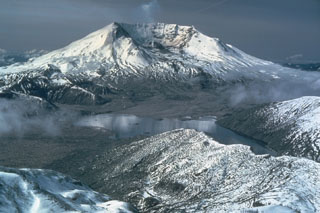Report on St. Helens (United States) — June 1986
Scientific Event Alert Network Bulletin, vol. 11, no. 6 (June 1986)
Managing Editor: Lindsay McClelland.
St. Helens (United States) Activity at background levels
Please cite this report as:
Global Volcanism Program, 1986. Report on St. Helens (United States) (McClelland, L., ed.). Scientific Event Alert Network Bulletin, 11:6. Smithsonian Institution. https://doi.org/10.5479/si.GVP.SEAN198606-321050
St. Helens
United States
46.2°N, 122.18°W; summit elev. 2549 m
All times are local (unless otherwise noted)
Deformation, SO2 emission, and seismicity remained at background levels through early July. EDM lines monitoring the dome's summit area and N and W flanks showed maximum deformation rates of 2-3 mm/day. Continuously recording tiltmeters detected no unusual changes. Seismicity remained at low levels. Seismic instruments recorded a few episodes in which several shocks occurred within a minute. Some events were felt by geologists working on the crater floor and one episode was associated with unconfirmed reports of plume emission. Similar activity has been recorded during previous inter-eruption periods. COSPEC monitoring on 3 days in June yielded only background SO2 emission rates of 15-25 t/d.
Geological Summary. Prior to 1980, Mount St. Helens was a conical volcano sometimes known as the Fujisan of America. During the 1980 eruption the upper 400 m of the summit was removed by slope failure, leaving a 2 x 3.5 km breached crater now partially filled by a lava dome. There have been nine major eruptive periods beginning about 40-50,000 years ago, and it has been the most active volcano in the Cascade Range during the Holocene. Prior to 2,200 years ago, tephra, lava domes, and pyroclastic flows were erupted, forming the older edifice, but few lava flows extended beyond the base of the volcano. The modern edifice consists of basaltic as well as andesitic and dacitic products from summit and flank vents. Eruptions in the 19th century originated from the Goat Rocks area on the N flank, and were witnessed by early settlers.
Information Contacts: D. Swanson, E. Endo, and S. Brantley, CVO; C. Jonientz-Trisler, University of Washington.

